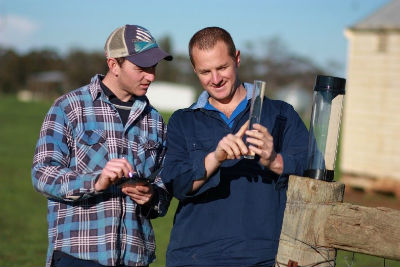Giving advice on chemical use
Many chemical users in Victoria rely on information provided by others when selecting and using agricultural or veterinary (AgVet) chemicals on their properties. For example, they might seek advice from:
- private agronomists
- industry representatives
- chemical resellers
- chemical company representatives
- our agronomists
- consultants
- neighbours.
Any person who provides advice about chemical use has a duty to ensure that the information they provide is accurate and reliable.
Ways of giving advice

There are various ways to provide chemical use information, such as:
- verbal communication
- written advice notes
- articles
- emails.
Written information is best because it reduces the risk of information being misinterpreted or forgotten. Information can be referred to by the chemical user at any time, which reduces the need to rely on memory alone. It also provides a record of the advice given. If things go wrong, this record can be used to determine whether the problem occurred as a result of the advice provided.
Legal obligations
Laws exist to protect chemical users who incur damage or cause contamination of crops or livestock from the misuse of chemicals as the result of bad chemical advice.
Section 59 of the Agricultural and Veterinary Chemicals (Control of Use) Act 1992 (the Act) addresses the provision of 'False or Misleading Statements'.
Any person who provides chemical use advice and causes a person who relies on the advice to commit an offence under the Act could be prosecuted by Agriculture Victoria or, if applicable, exposed to civil litigation by the affected party for the recovery of any losses incurred.
Duty of care
Any person who provides AgVet chemical use advice has a duty of care to ensure that:
- the information they provide is within their area of skill, expertise and employment
- the information they provide is accurate, unambiguous, qualified (if appropriate), and applicable for a specific period of time
- an accurate written record is made and kept of the information provided
- professional liability insurance is held (if appropriate).
On-label advice

Chemical product labels provide detailed information about:
- what agricultural produce the chemical can be used on
- the pests that will be controlled or the effect the chemical will have
- application rates
- any withholding periods that apply
- any specific precautions or restrictions that apply.
Providing on-label advice presents the lowest level of risk. Any person who provides advice about chemical use that is entirely consistent with the product label has a high degree of risk protection because the label is a legal document that is warranted by the product manufacturer.
Off-label advice
Advice about the use of a chemical product other than by the directions for use specified on the product label is called 'off-label' advice. The person who provides off-label advice, together with the chemical user, is responsible for any negative consequences that might result from the user following the advice.
There are three areas where providing off-label advice is an offence under the Act. These are:
- when the advice, if relied on, would cause a user of the chemical product to breach part of the Agricultural and Veterinary Chemicals (Control of Use) Act 1992 or the regulations made under the Act
- when the advice, if relied on, leads to the contamination of stock animals or agricultural produce
- when the advice, if relied on, would injuriously affect plants to which the chemical product is to be applied.
Maps and other information
People who use or coordinate agricultural spraying contractors for agricultural spraying work may provide the applicator with information (for example, maps or diagrams) relating to the areas to be sprayed.
Information provided to spray contractors must be accurate and reliable, and contain information on:
- the target area
- its surroundings (for example, crops or livestock, waterways, dams)
- the location of sensitive areas (for example, a school, hospital, aged care service or children's services such as kindergartens or childcare centres) within 200 metres of the land to be sprayed.
It is an offence for a person to provide maps or diagrams containing information about agricultural spraying to agricultural spraying contractors where the information leads the applicator to commit an offence under the Act.